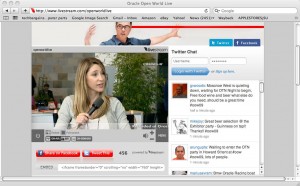One of my first freelance copywriting clients after I moved to San Francisco was a very smart guy who had been direct response ad manager at Oracle. He based his strategy at his new company on what he had learned and done there, so I learned as well.

In a day when most tech marketing was fairly dweeby and feature-centric, Oracle took the advantage by brute force. Every day in the lower right corner of the local edition of the WSJ, there was an ad with a bar chart showing how much faster Oracle was than Sybase, then their major competitor because then Oracle was mainly a database company. And I myself considered applying for an ad manager position that was advertised in Adweek. Most classifieds described the job and the qualifications; Oracle simply ran a huge headline that said PREDATOR and follow-on text to indicate that’s how they wanted you to treat the competition.
During and just after the dotcom era, Oracle discovered an even more effective strategy to beat the competition: buy them. First there was Peoplesoft, then BEA, then Siebel (founded by an ex-Oracle marketing guy), now Sun. Today Oracle is a conglomerate and Sybase, its original competitor, has shrunk to 3% market share in its single market.
I was thinking about this history as I walked through Oracle OpenWorld, actually the first time I have attended in spite of my long Oracle history. It’s the only event I know of the many conventions held each year at Moscone that closes a major street so the party tent can be erected there. The result is gridlock throughout downtown San Francisco—classic smash-face marketing because everybody who is stuck in traffic is thinking about Oracle.
The typical OOW attendee is a database administrator (DBA) in a large organization. A key purpose of the conference is to make this typically mild-mannered individual feel like the most important person in the world by identifying with the Oracle juggernaut. I’m writing this post in an absolutely packed ballroom with thumping music and flashing visuals where the faithful are waiting, not for Roger Daltry or Aerosmith (they’ll be at the Customer Appreciation Event tonight) but for CEO Larry Ellison’s keynote.
With such a loyal fan base, using social media for marketing is an obvious choice and the Oracle folks are doing it well. The best example is OpenWorld Live, a website where you can watch a live feed (often with a couple of guys interviewing passers by about how happy they are to be at OOW) and simultaneously keep up with the tweets rolling by with #OOW09 as the hashtag. At the bottom of the page are buttons to take you to the Oracle conversations on Facebook and LinkedIn and even some code in case you want to embed the video on your own site. All Oracle, all the time, even when your laptop is propped up on your lap in the hotel room.
Commercially, Oracle is pushing a concept called Social CRM. I attended a briefing where Tony Lye, Oracle VP for CRM, talked about the concept of a “Listening Post” which will be incorporated in future releases. His prototype can gather and monitor conversations about Oracle anywhere in cyberspace (Lye though he was the first to do this, which isn’t true) and feed them into a sales and marketing interface such as Salesforce.com where they can be parsed by sales territory or other factor and the sales team can hunt down opportunities or put out fires. You’ll need a big database to do this effectively, and Oracle has one to sell you.